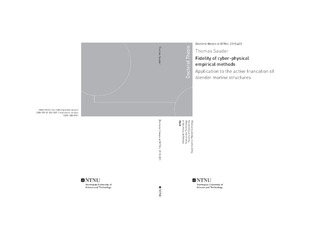Fidelity of Cyber-Physical Empirical Methods Application to the active truncation of slender marine structures
Doctoral thesis
Permanent lenke
http://hdl.handle.net/11250/2583465Utgivelsesdato
2018Metadata
Vis full innførselSamlinger
- Institutt for marin teknikk [3421]
Sammendrag
Cyber-physical empirical methods (CPEMs) are empirical methods in which a dynamical system under study is partitioned into physical and numerical substructures. While the numerical substructures are described by validated computational models, the behaviour of the physical substructures is partly unknown. CPEMs allow to address problems in e.g. mechanical and electrical engineering that classical empirical methods alone, or models alone, cannot address in a satisfactory way. In CPEMs, the substructures are interconnected through a control system that includes sensors and actuators, having their own dynamics. The present thesis addresses how the fidelity of CPEMs, that is the degree to which they reproduce the behaviour of the system under study, is affected by the presence of this control system.
In our work, the control system is represented by a parametrized set of elementary artefacts, such as sensor calibration error, bias, noise, time delays, signal loss, and actuator dynamics. Their describing parameter is assumed to be the realization of a multidimensional random variable with a known, but arbitrary, distribution, obtained from dedicated surveys or based on experience. The proposed analysis method enables the designer of a CPEM to (1) identify the artefacts that play a significant role for the fidelity, (2) define bounds for the describing parameter ensuring high-fidelity of the CPEM, and (3) evaluate whether probabilistic robust fidelity is achieved. These analyses are generally to be performed in a high-dimensional space, and involve non-closed form models of the substructures, which are possibly expensive to evaluate. To make the problem tractable, our strategy was therefore to apply adequate surrogate modelling technique, namely Polynomial Chaos Expansions (PCE) and Polynomial Chaos-based Kriging (PCK).
The proposed method is first illustrated by a simple example involving coupled linear oscillators. It is then applied to the analysis of the active truncation of slender marine structures, a problem of direct relevance for hydrodynamic model testing of floating structures in ultra-deep water.
